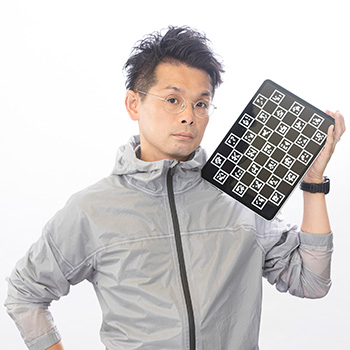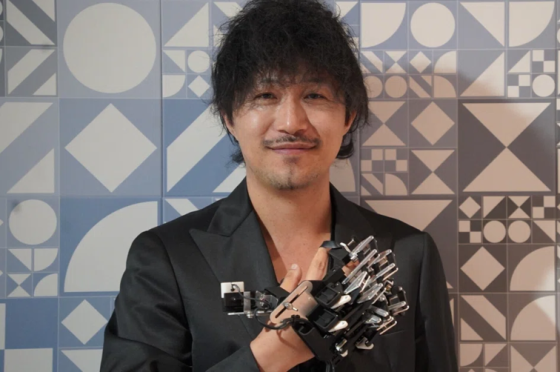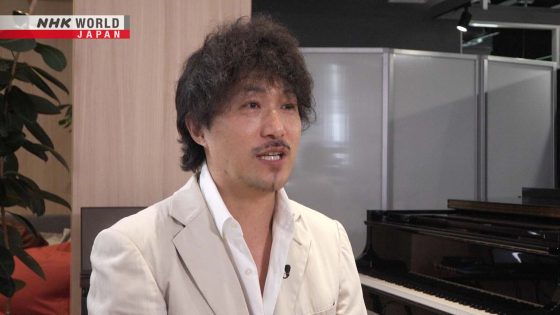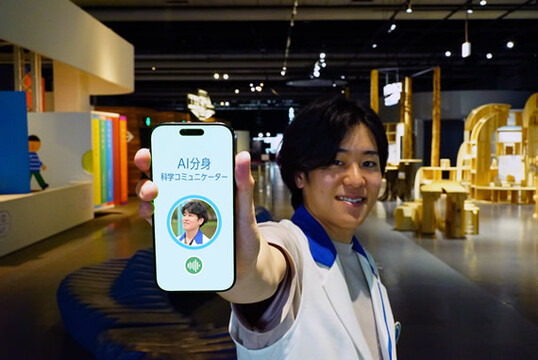Transboundary Research
コンピュータと融合する新たな人間性
「サイバネティックヒューマニティ」の探求
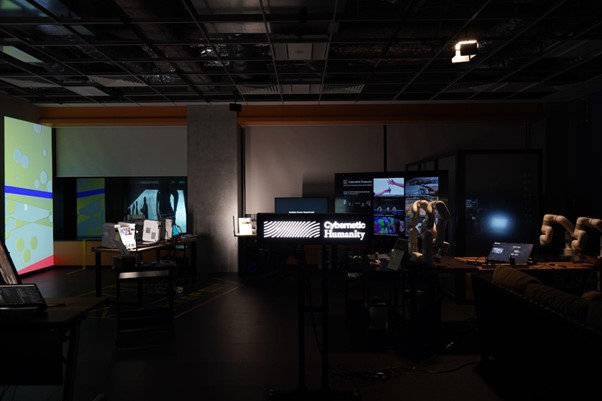
Cybernetic Humanity Studio のオープンラボ
コンピュータ技術をつかって、人間の知覚や認知を拡張・変容させる研究「Superception(超知覚)」を探求する笠原研究員。現在は Superception がベースとなる未来における人間性「サイバネティックヒューマニティ」の探求を、OIST(沖縄科学技術大学院大学)で進めています。2023年4月21日にはOISTに新設された「Cybernetic Humanity Studio」のオープンラボとともに、公開セミナーが行われました。同セミナーの内容を中心に、サイバネティックヒューマニティ、そしてOISTの研究環境についてレポートします。(記事:森 旭彦 / サイエンスライター)
※本文は、一般的には複雑な概念について説明している場合があるため、適宜内容に加筆等を行っています。
【サイバネティックヒューマニティとは何か?】
現代に生きる私たちは、どこまでが自分なのでしょう? ソーシャルメディア上では、何年間もテキストだけで交流している友だちがいます。あるいはメタバース上でアバターを通して交流している関係性は、一体どのようなものとして私たちの人生へと統合されていくのでしょう?
「“この現実”では、自分というのは明確ですよね。いま、ここにいる自分です。しかし、メタバースやバーチャルリアリティでは、自分ではあるけれど、“この現実”の自分とは異なる自分が生まれます。一体私たちは“この現実”の主観的な自分と、バーチャルリアリティ上の自分の間でどうやってバランスをとるべきなのか。それが私の問題意識です」と笠原研究員は話します。
笠原研究員は、研究者とアーティストという2つの性質を持って活動しています。研究者として、コンピュータと人間が融合したときの「自己」について研究を進めてきました。そして、それらをアート作品として提示することで、“この現実”とは異なる性質を持つ、コンピュータと融合した自己について、社会でどのように受け止められるのかを探求してきました。
「バーチャルリアリティにおける自分は、たとえば現実では不可能なことができます。高いところから飛び降りても平気だったり、空を飛ぶことができたり。まるでビデオゲームの世界です。こうした世界で起きていることが、テクノロジーの進歩によって、“この現実”でも起きたとしたらどうでしょう? 私たちは、(バーチャルリアリティ上の)自分(の経験や技能)をどのように、“この現実”で受け止めればよいのでしょうか? サイバネティックヒューマニティは、そうした現実における、新しい人間性を探求する研究領域です」(笠原)
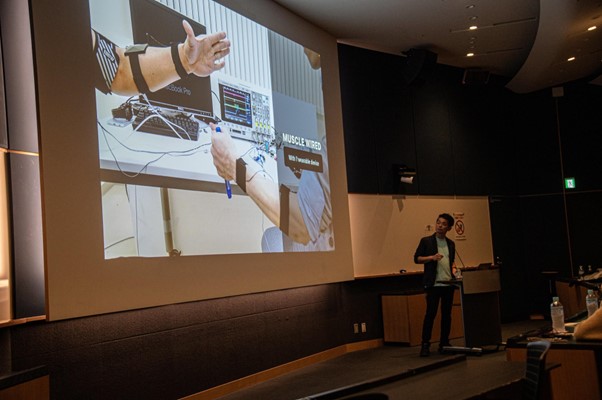
【自分の行為とは何か】
サイバネティックヒューマニティにおいて、まず重要になるのが自分の「行為(action)」です。高度なテクノロジーと共存する現代において、どこからどこまでが、自分の行為なのでしょう? 笠原研究員は、自分の行為と、自分以外の行為の境界線を、人間の認知の限界を示すことで説明してみせます。そのトリックは実に明快で、「ペンドロップ(ペンを落とす)」だけです。
「〈Wired Muscle Project〉で着目したのは、私たちの身体が持つ“遅延”です。目で見て、身体を動かすには、250msという遅延が発生します。(この遅延がある限り、人は、他人が無作為に落としたペンをキャッチすることができません。これは生体としての限界です)私たちが車に乗って、目の前で起きた事故を回避できない場合があるのはこの遅延のためです」(笠原)
〈Wired Muscle Project〉では、この遅延をテクノロジーによって克服したとき、人間がどこまでを自分の行為と捉えるかを探求しています。その仕組は、ペンを落とす行為と、それをキャッチする行為を“直接繋ぐ”というものです。つまり、ペンを落とす人の筋肉の信号を読み取り、キャッチする人の筋肉を電気刺激で動かす(先制行動:Preemptive Action)ことで、この遅延を60msまで縮めるのです。すると人は、現実では不可能であるはずのペンをキャッチすることができるのです。
「このプロジェクトの興味深い点は、このデバイスを使ってペンをキャッチできた人は『やった!(I did it!)』と言うわけです。デバイスによって可能になっているのに、自分がやったことだと思う。私はこの現象の仕組みを特定するために研究を進めました」(笠原)
笠原研究員は、人間がどの程度の遅延の短縮を「自分の主体的行為」だと認識するのかを調査しました。すると、先制行動が自己の行動だと認識される最適値は80msまでだったといいます。この研究をもとに笠原は、より複雑なタスクでの研究を進めてきました。そのひとつが〈Whose touch is this? 〉です。
この研究では、電気刺激によってユーザの筋肉を収縮させ、ユーザが認識するよりも早く身体を動かし、2択のクイズに答えるという実験を行っています。実験においてユーザは、コンピュータによって意図的に正解へと、また、不正解へと誘導されます。すると、ユーザは自分が正解したときは「自分がやった」と思い、間違ったときは「機械のせいで間違った」と判断したといいます。このことから、ユーザの主体性帰属は結果によって偏ることがわかりました。笠原研究員らは、この偏りは結果による主体感バイアスであると推測しています。
さらに笠原研究員らはこの仕組みを、ロボティクスへと持ち込み、ピンポンをすることを試みました。
「ロボットアームを操作して人間がピンポンをプレイすることは非常に困難です。システムに遅延があることから、人は速い球に適切に反応することができません」(笠原)
どのようにすればロボットアームを自分の腕のように操ってピンポンをプレイできるのでしょう? 笠原研究員らは、ロボットアームに自動でピンポンを行わせ、そこに人間の身体の動き(motion)を統合すること試みました。
「(調整によって、ある一定の条件のもとで)自分の行為主体感を保ちながら、ロボットアームでピンポンをすることに成功しました。つまり、自分がやっているという感じを残し、ロボットとの融合を実現したのです」
この実験で表現されていることは、実際にはロボットが自動で反応していることではありながら、人間が「自分がやっている」と認識できるような行為をつくったということです。こうした行為が、現実で実現するとき、私たちは一体どこまでを「自分の行為」と考えるのでしょう?
【自分の身体とは何か?】
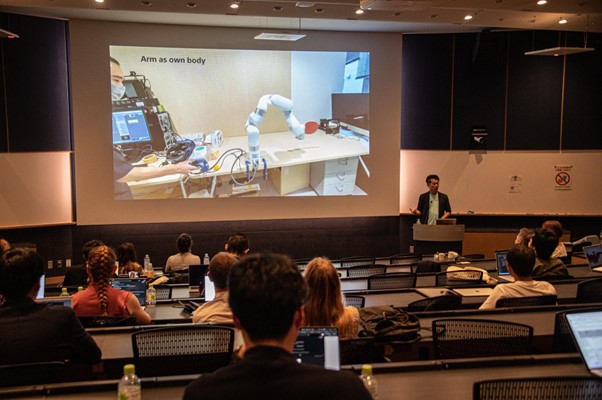
自分の身体とは何でしょう? 一見、自分の身体は「ここにあるこの身体」です。しかし笠原研究員は、「自分の身体の視覚を、空間的・時間的に変形した状態に置き換えることで、体感を変化させる」ことを実現しました。それが〈Malleable Embodiment 〉です。
「(Malleable Embodiment では)物理的には何の操作もしていません。ただやったことは、コンピュータによって身体の未来の動きを予測し、それを視覚情報としてユーザーに返したのです。するとユーザーは身体を軽く感じることができました。さらに身体の動きを遅くしたものを返すと、ユーザーは身体を重く感じました。まるで『二日酔いの状態』ですね(笑)。この研究によって明らかになったことは、私たちは身体の感覚を、視覚情報だけで変化させることができるということです」
さらに笠原研究員は思い切った研究に挑みました。私たち人間は「ひとつの意識にひとつの肉体」です。笠原研究員はこのユニバーサルデザインを、書き換える研究を行いました。それが〈Parallel Ping-Pong〉。ふたつのロボットアームをひとりのユーザが操作し、2つのテーブルでピンポンをするというものです。
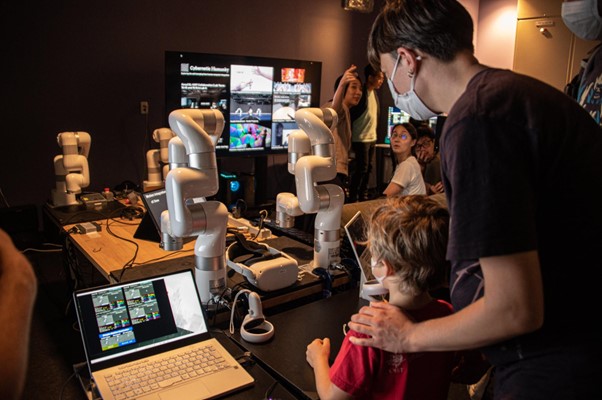
Cybernetic Humanity Studioのオープンラボで展示されていた〈Parallel Ping-Pong〉。
「人間は自分の行為主体感を保ちながら、ロボットアームでピンポンをすることができることは先の研究で実現しています。そこで、次はロボットアームを増やしたわけです。ここで挑戦したことは、まだ私たちが実現したことのない『複数の身体に適応する』ということです」(笠原)
しかし実際のところ、人間の意識はひとつです。「どうすればひとつの意識でふたつのピンポンをプレイすることができるのか? 重要なことは複数の身体を使いこなすためのテクノロジーです。それを探求したのが、〈Pararell adaptation〉というプロジェクトです」と笠原研究員は話します。
通常、ひとつの意識でふたつのピンポンをプレイするためには、2つの身体の特性に適応しなければなりません(二重適応)。しかし、現実の異なる視点に立つロボットアームに二重適応することは、「ひとつの意識にひとつの肉体」をもつ人間には不可能です。
そこで笠原研究員らはこれらの身体間に、バーチャルリアリティ上で強い視覚的な“手がかり”を与えることで、「二重適応」を可能にしたのです。この研究 により、ユーザーは視覚上でふたつの身体に適応することができることが明らかになりました。
これらの研究がパズルのピースを埋めるようにして、〈Parallel Ping-Pong〉が実現しています。〈Parallel Ping-Pong〉では、コンピュータと人が融合することで、人ができないことが、行為の主体感を残しながら可能になっています。しかし、このロボットはユーザにとって「自分の身体」なのでしょうか?
【自分とは何か?】
自分とは何か、それは数多くの哲学者が挑んできた難問です。笠原研究員はこの難問に対し、「自己として認識できる程度」はどれくらいかを、テクノロジーによって探求しました。それが〈Morphing Identity〉です。
自動証明写真のブースのような空間に入った2人が、最初はふつうに話し合っているように見えますが、徐々にお互いの顔がブレンドされていき、最後は入れ替わってしまいます。〈Morphing Identity〉の仕組みは、2者それぞれの顔を分析し、2者間にどのような顔が存在するかを「GAN」(敵対的生成ネットワーク)によって生成し、それらをリアルタイムのアニメーションにするというものです。
「〈Morphing Identity〉によって、自己認識には“幅”が存在することがわかりました。私たちは〈Morphing Identity〉を展示場に設置し、7600人におよぶ人に体験いただき、情報を集約したところ、総合して20%のモーフィングまでは『自分だ』と判断することがわかりました」(笠原)
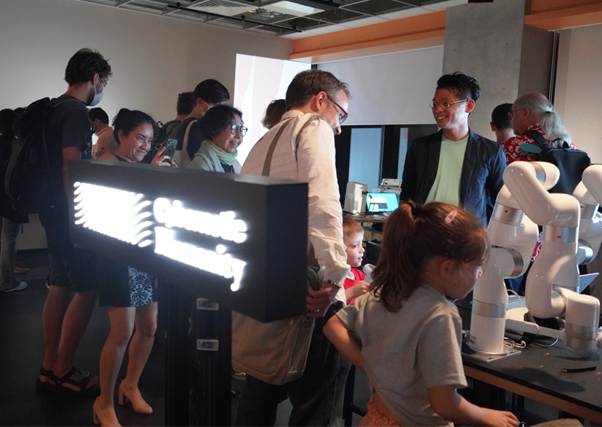
Cybernetic Humanity Studioのオープンラボの様子。
【アナトール・レキュイエール博士による擬似触覚(pseudo-hptic)の研究】
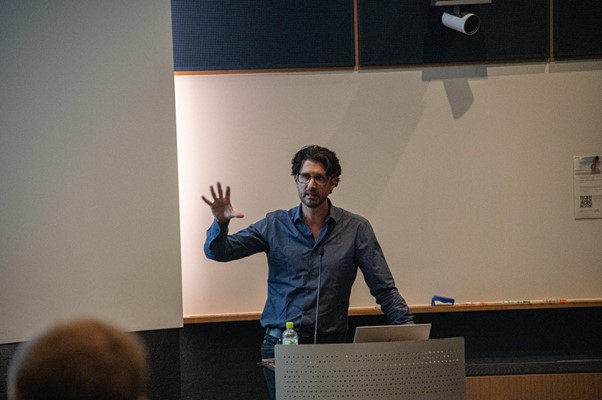
今回のセミナーは、OISTに短期滞在しているアナトール・レキュイエール博士(Anatole Lécuyer)と共同で行われました。レキュイエール博士は、フランスの研究所「INRIA(※)」に所属しており、「擬似触覚(pseudo-hptic)」というテーマにおいて、印象的な研究を多数行い、多くの論文を発表してきました。
「興味深いことに、私たちの研究室では、ローテクを駆使したアプローチをするのが好きです。そして、現在の技術の限界を補うトリックを見つけることです」とアナトールは、セミナーのトークで自らの研究について紹介しました。
疑似触覚は、触覚への直接的な刺激を行うことなく、触覚をシミュレートするというものです。中でももっとも“ローテク”でありながら、示唆に富む研究が、コンピュータ画面上のカーソルの動きだけで「隆起」と「穴」の触覚をユーザに感じさせる疑似触覚です。
「この研究 では、マウスのような入力デバイスで、凹凸や穴などのマクロな質感を識別することに成功しています。それも、カーソルのスピードを(表示されている画像等に合わせて)遅くしたり、速くすることによって可能にしています」(レキュイエール)
レキュイエール博士の論文は、とくに触覚(ハプティクス)を専門とする研究者にとっては数多く引用されており、セミナーの最中には聴衆から「アナスタジア」(「シナスタジア(共感覚)」をもじった、「アナトールの感覚」というユーモア)という言葉も飛び出しました。
アナトールらの研究チームは擬似触覚をさまざまに応用していますが、中にはデジタルアバターを利用したものもあります。この研究は 、デジタルアバターがウェイトリフティングする視覚情報から、現実の触覚に錯覚を与えるものです。
「この研究は“二日酔い”に似ているかもしれませんね。ダンベルを持ってウェイトリフティングをするデジタルアバターの動きを減速したり加速したりすることで、(現実において)重く感じたり、軽く感じたりできます。将来的には、エクササイズへの応用などが考えられます。ユーザーへの負荷を人工的に増減させることができるでしょう」
また、アナトールらの研究チームは、BCI(ブレイン・マシーン・インターフェイス)の研究にも数多くの業績を出しています。そのひとつが、BCIに特化したオープンソースライセンスのもとで配布されるフリーソフトウェア「OpenViBE 」です(編集時に参照した論文の筆頭著者はYann Renard)。BCIは、脳の活動からコンピュータに命令を送ることができるコミュニケーションシステムであり、現在医療分野などで応用が進んでいます。
「私たちはOpenViBEを用いて、脳の活動のみでビデオゲームを行ったり(2013)、Microsoft Hole Lensを用いて、拡張現実(AR)上で、移動ロボットを制御することを実現しています(2020)」
【OISTにCybernetic Humanity Studioをオープンする理由】
行為、身体、そして自分に、独自の視点で探求してきた笠原研究員は、「サイバネティックヒューマニティ」を探求するモチベーションのひとつに、個の研究を社会へと拡げていくことを挙げます。
OISTでは国内外の研究者との交流が活発で、ワークショップやカンファレンスなどを通して訪れる科学者の数は年間1,000人だといいます。OISTにおいてサイバネティックヒューマニティが探求される意味は、レキュイエール博士のような、非常に高い研究実績を持つ科学者との交流にあると言えるでしょう。まさに個別の研究から社会へと地続きになる場所が、OISTなのです。
「これまでの私の研究は、個々の現象に焦点をあてていました。しかし、技術がますます人間とコンピュータを融合し、社会に浸透していく現代において、個別の研究だけではなく、社会までを対象として、これからの人間性を捉えていかざるを得ないと考えています。それがサイバネティックヒューマニティとして、ソニーCSLとOISTをつなぎ、探求したいことなのです」(笠原研究員)
※INRIA: Institut national de recherche en sciences et technologies du numérique/フランス国立情報学自動制御研究所
(記事:森 旭彦 / サイエンスライター)
参考:
日仏共同セミナー「メタバースとバーチャルリアリティ 」レポート(沖縄科学技術大学院大学)
https://www.oist.jp/news-center/news/2023/5/18/oist-hosts-french-japanese-seminar-metaverse-and-virtual-reality
プログラム案内:Public Lecture: Metaverse and Virtual Reality by Anatole Lecuyer and Shunichi Kasahara(沖縄科学技術大学院大学)
https://groups.oist.jp/tsvp/event/public-lecture-metaverse-and-virtual-reality-anatole-lecuyer-and-shunichi-kasahara
